 eehnie Fri Oct 14, 2016 7:04 am
eehnie Fri Oct 14, 2016 7:04 am
Sorry for the long list of questions, these are all thoughts i have been wondering about for the past 2 years or so. They are ver interesting questions. I myself, I'm trying to find the answer to some.
I am not sure I follow the understanding between the active russian army and the reserve russian army - this reserve army used for fighting in the CIS for low technology wars - is this the same as the amalgamation of the interior ministry troops, border guards and drug units? Is the intent to keep t72, t80 and t90 for the contractor/professional full time army and to use up all the t64,t62,t55,bmp1/2 in the reserve army? About the warfare, the active force includes the warfare working every day in the defense of Russia. The reserve includes the warfare owned by the Russian Armed Forces that is stored and out of the daily work (as consequence nothing to do with other security forces outside the Armed Forces that you mentioned). The reserve warfare is used in conflicts when the Russian gouvernment wants not to touch its active force and need not it. I look less about the soldiers and its status.
When vehicles are put into storage in russia what are the conditions like, is it facilities protected from weather or are they just left out in the open to rust? For the warfare stored since years ago, the conditions have not been good. This begins to change for a little more modern warfare that begins to be stored recently.
If you are going to leave them out in the open exposed to elements and they are going to decay why not just scrap them strait away, at least you make jobs for a period of time and can get some use out of old materials... The cost was very high for the big numbers of vehicles stored. Also to scrape them has a cost that was not affordable for all at the same time. The reserve warfare is to be used if needed, must be useful.
Will this reserve army be manned by conscripts or contractors as well? The reserve warfare is used many times by former veteran soldiers that worked with them before.
I was wondering, what has russia done with the 14,000 AFV that it retired a few years ago? According to the data these 14000 infantry armoured vehicles were moved from active service to the reserve. At the time it was not a reserve of infantry armoured vehicles, now there is a reserve of 15500 vehicles. Type by type the total numbers remain very close to the initial numbers. Only the BTR-50 disappeared.
When Putin ordered the T55,T62 & T64 to be withdrawn from active service were they sold off or scraped or put into storage? What exactly is the plan for all these vehicles? Likely the first step was to move them also from the active service to the reserve. But in this case it has been more scrapping activity, as we can see in the reports of the sales and auctions of scrapping material. Also in this case the war of Syria had an important effect, since it has been reported the procurement of T-55 and T-62 to Syria. It is necessary to remember that the war started in 2011, almost at the same time than the plan of decommissions and scrapping.
With the reduction in defence budget and the surplus of hulls will they go ahead with the t55 heavy infantry transport to save costs and increase protection ? Russia stoped in 2010 the development and procurement of most of the programs like this, this included. They do for other countries.
Ive seen american documentary that afghanistan is still using t62's why doesnt russia supply them with replacement t62s to reduce its arsenal? They currently have 40 working vehicles left i think - just type into google "t62 stars and stripes" Surely the war in Syria is absorving the old Russian T-55 and T-62. Likely all them, in order to keep the strength of the Syrian Armed Forces in close levels to 2010.
How do the russians think about return on investment in terms of equipment? I mean it cost them billions to make all these vehicles, how much use or return do they aim to get out of each vehicle before they decide to chuck them out? Is there a pre-determined number or rough goal? e.g. if they got 30 years service out of a single t62 then what happens to it next is not important as it achieved the desired return on investment so it doesnt matter if it gets scrapped, sold off, donated etc With higher investment on maintenance surely these vehicles would remain longer, but it requires more money. The strategy of scrapping the oldest material proved to be wrong for the US and their allies. Now the US backed militias in Syria must fight in trucks vs the Syrian Armed Forces, that have enough old tanks to keep the advantage despite some loses.
Ive seen on wikipedia (dont know how reliable) that russia still has 7,000 BMP1's. Whats the current plan for all those, are they going to swap out main guns on them to BMP2 in future or let them rust in junkyards, sell them or auto-mate them into robot tanks? The Russian strategy of keeping the old material proved to be right in the War of Syria. The oldest material is proving to be good enough to win this war. The BMP-1 will likely wait its turn in the line of procurement.
Last edited by eehnie on Wed Jul 19, 2017 11:32 am; edited 1 time in total






 SeigSoloyvov
SeigSoloyvov




